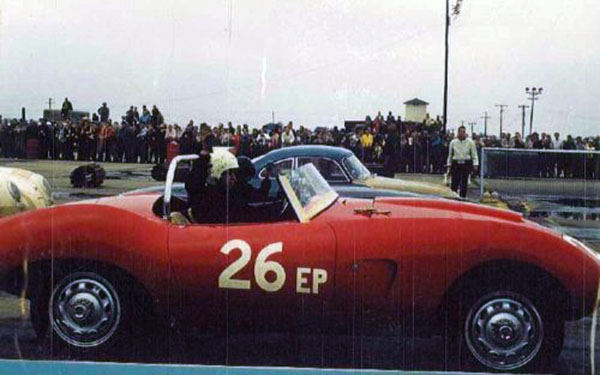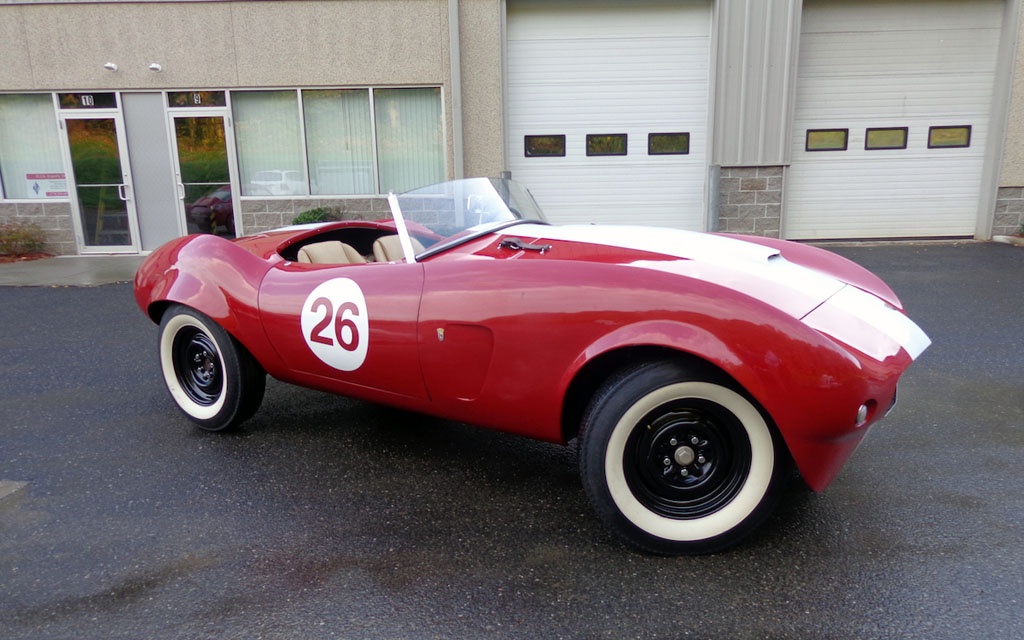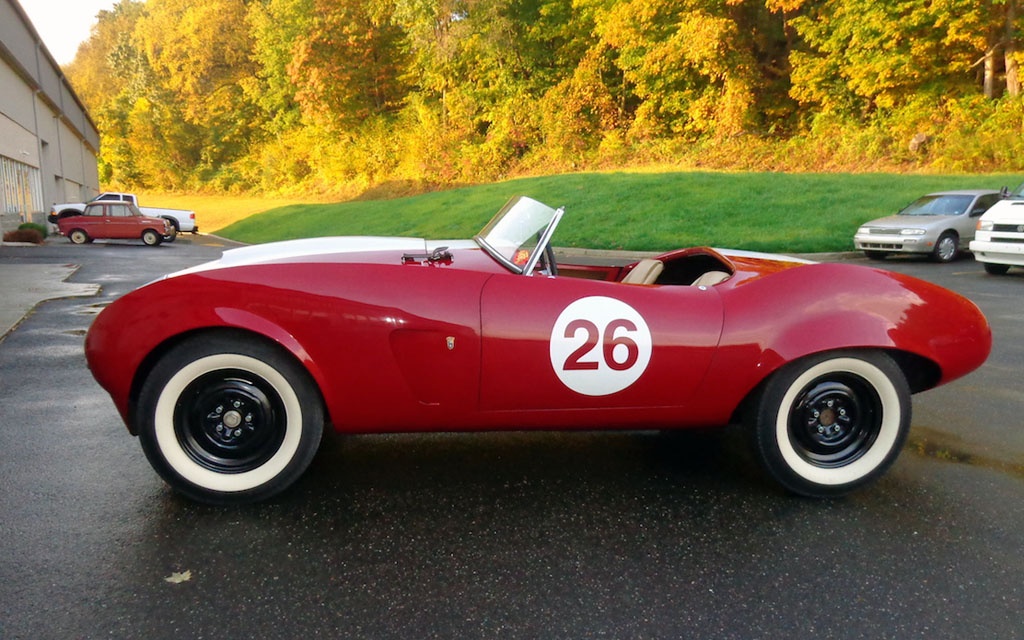They say the best things come out of collaborative efforts and based on the 1954 Arnolt Bristol above, I’d have to agree. There are other great examples, like the De Tomaso Pantera and the Intermeccanica, but those cars were simple collaborations between Italy and America. The Arnolt Bristol took it to a new level, as it was an American car with an Italian body and a British drivetrain. Only someone as whacky as Stanley Arnolt could have ever envisioned something like the Arnolt Bristol and I’m just glad he was able to pull it off, even if only 142 were ever built. This one was used for racing almost from day one and was raced until ’59. Over 50 years later, it is back on the road with the number 26 still emblazoned on its sides. Have a look at it here on eBay or see it in person in New Milford, Connecticut.
As you can see, this one has already been restored and is looking great. I’m not sure I like some of the changes that have been made to it over the years, but most of the cosmetic changes can be reversed with little trouble. Finding some of correct parts could be difficult though. At some time in its past, the original Bristol engine was replaced with a 265 Corvette V8. While it offers more power, it will likely hurt the car’s value. Also, you will notice that the rims are not the ones from the 1956 photo. This originally came with Borrani knock-off steel rims, making it one of only 9 cars to receive this particular option. For the time being, the current black steelies will work just fine though.
While I don’t care for the customization that’s been performed to it, I’m glad that whoever did the work tried to retain some of the car’s history. They were careful not to damage any of the old race plaques, the original steering wheel, or the original seats. It is an interesting mixture of new and old, but I think I would have preferred this car to be more old and less new. I can’t help but wonder what the original owner would think of their car as it sits today.
Given the lack of the original Borrani rims or the original motor, I’m not sure the seller will be able to get their $137,500 asking price. They will have to find a buyer that is alright with the modifications, but still appreciates the history of this particular car. If it were original, or at least closer to it, it would be a much easier sell, especially with its racing history. As it sits now, I would recommend that the seller list it at one of the large auction venues. That being said, I’m glad to see this car is still on the road and I sure wish I could take it out for a spin! So does anyone here remember seeing Arnolt #26 racing around the track back in the late ’50s?






Trust me…….the aren’t any better looking in person. The design is so out of whack with the suspension. They sit so high they remind me of a sport car 4×4.
Perhaps someone here could educate me on the merits of the car. I always ready to learn.
Bristol was a highly regarded British aircraft maker during WW2 and wanted to get into the luxury car business post-war. They purchased the rights from BMW to manufacture their very successful prewar ‘328’ engine. When many others were using flathead cylinder heads, this pre-war inline-6 engine had an overhead valve arrangement that breathed much better, but made for a very tall engine. It didn’t help the height that the carburetors were also positioned above the engine – but this was part of the Bristol Chassis+engine package which Arnolt asked Bertone to clothe. Bertone had recently hired Franco Scaglione – a highly intelligent and gifted aerodynamicist who turned to car design when Italy was banned from building aircraft after the war. The tall engine was not a problem for a tall stately limousine, but any sports/racing car designer would have been highly challenged by the problem. The ‘merits of the design’ to answer your question is that Scaglione dropped the hoodline on either side of the tall engine but then added a sharply creased line at the outer edge of the front fenders – knowing that those creases would literally pull the viewer’s eyes away from the tall center towards the outside. Without the sharply creased fender lines, the car would look strange indeed. He also used a hood scoop over the carburetors to drop the hood line lower on either side of the scoop.
That the cars normally sat high was a function of the Bristol chassis design. That the total design was successful there can be no doubt since Arnolt Bristols took 1st, 2nd, and 4th in class at their first race outing – the 1955 Sebring 12-hours. They were soon out-classed by more modern designs, but by using some of the best pre-war designs from BMW, Bristol gained a head start in that early post-war period.
Scaglione was the Gandini (modern-day exotic car designer) of his day – designing some of the most memorable designs of the 1950’s: (Alfa Romeo’s B.A.T. cars, Sportivas, & especially the Giulietta Sprint Coupes that not only turned Bertone into a manufacturer but saved Alfa Romeo as well) and of the 1960’s: (from the ATS Coupe, Alfa Romeo Stradale, and Lamborghini 350 GTV to the Intermeccanica Italia Roadsters).
BTW, the creased fender line trick that Scaglione used to pull the eye outward on the Arnolt Bristol can be seen even today on beautiful designs like the hood of the 1996 Buick Riviera… That a design solution from the early 1950’s would still be useful on a production car 40 years later speaks highly of it’s merits.
The merits are greatly lessened with the wrong motor and wheels !
The fender flairs look ridiculous on this historic classic, what a travesty!
I don’t think that front air dam is original either.
Not the prettiest car, but Wacky’s first Bertone order – the Arnolt MG – literally saved Nuccio’s company from going to the wall in the early fifties.
Another hatchet job on a truly rare car with international connections—Italian body designed by Franco Scaglione and built by Bertone, British drivetrain, conceived by US enthusiast Whacky Arnolt. Not one of Scaglione’s best compared to the great bodies he designed for some of the most coveted vintage Ferraris on the planet, but he was constrained by the chassis and tall Bristol engine.
Agreed it sits too high on its suspension, but these were a rare effort by enthusiasts from different parts of the globe and ought to be kept as their creators made them. They were light and had some pretty good competition success. They didn’t make many of these, so the boy-racer / hot rod job is all the more unfortunate.
The seller had a Fiat Abarth Zagato coupe for sale some time ago that was featured on BF, and also has some videos of cars he’s selling on Youtube. The auction has been taken down because the car is no longer available. Tough to value this because they are an acquired taste, and this one has been butchered, but I don’t think the $137K price would have been out of line for a car with a documented competition history. But you’d want to confirm that with more than a few vintage race photos and dash plaques. Then deduct a big whack of value to correct what’s been done to the car and source a proper drivetrain, which won’t be cheap.
Just a minor correction… Scaglione only ever designed one body for a Ferrari – the 1953 Ferrari 166M Abarth Spider race car. Since it was difficult to find a photo that makes it look as good as this one does, it’s probably my least favorite Scaglione design ever, yet it shows some of his early thinking as a trained aerodynamicist – with the central headlight and two nose openings on either side evoking the dawning age of jet aircraft such as the new Lockheed Shooting Star. Note too the dramatic brake ducting on the sides of the rear fenders – a concept he used again (though seldom visible) underneath the front fenders of the amazing 1953 Alfa Romeo B.A.T. 5 car.
Franco Scaglione is indeed responsible for many coveted car designs – the Alfa Romeo Tipo 33 Stradales probably highest among them. He’s probably the best of the least-known designers – though I think his star has been rising slowly over the past 10-15 years. Perhaps if he had designed more Ferraris his name would be much more famous.
Won’t have to worry about grounding on speed bumps in this car, …something I had to fret over in my classically low slung Healey. Something just looks out of whack on this car. Being “rare” doesn’t always do it for me.
Rarity doesn’t always do it for me either, but I get impressed when a wacky ‘Merican gets a car designed and built overseas, which takes 1st, 2nd, and 4th in class at the Sebring 12 hour race in its first attempt. Then 2nd and 3rd in class the next year, then 5th another year, then 1st in class again 5 years after its debut, against younger cars. That’s a record that tends to make a homely car look a lot better.
And…it’s gone.
Hmmm… “No longer for sale” = Someone made an offer too good to refuse?
I also wonder about the modifications. And I would be curious if the “restoration” was documented with photos, so that the starting point could be seen.
josh:
would you be kind enough to contact me regarding the arnolt-bristol.
thanx
michael